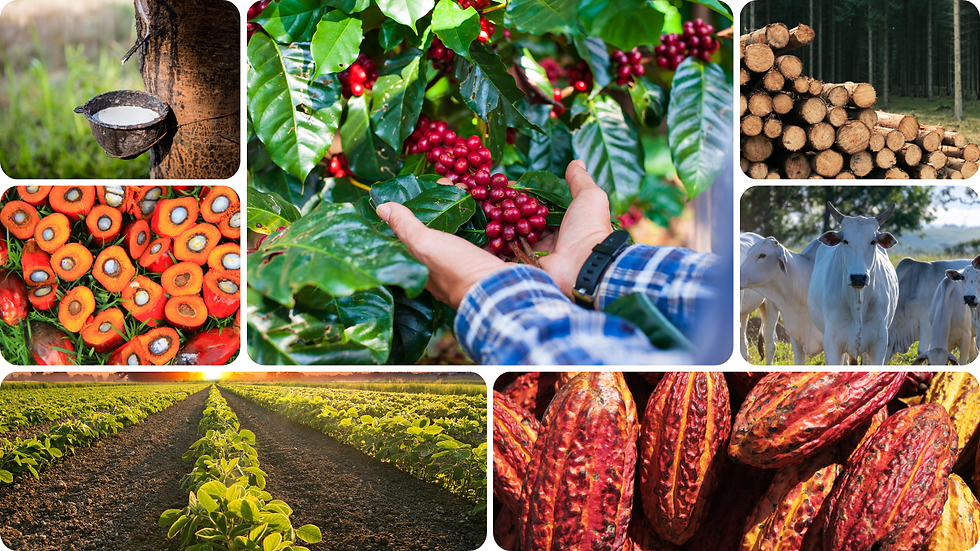The EUDR is changing the game for farmers. SAN is helping them adapt.
- Communications

- Aug 20
- 4 min read
Updated: Sep 10
In 2019, the European Union (EU) published a communication stressing the need to step up for the protection of forests. Citing a global loss of 1.3 million square kilometers of forests between 1990 and 2016 and understanding its power as home to 450 million consumers, the EU vowed to take measures to promote more sustainable value chains.
So was born the European Union Deforestation Regulation (EUDR), enacted in 2023 and currently in its last phase towards full implementation. Its drafting involved a hard look into the different products that arrived in Europe from extensive agriculture backgrounds and modified two key aspects: the scope of the oversight and the compliance needs along the value chain.
Up to then, forests were protected in European legislation by the 2010 Timber Regulation, a set of measures set in place to prevent illegal logging, and applicable only to timber and timber products. Less than ten years later, there was a clear understanding of how this regulation fell short: much of the damage to forests doesn’t come from the exploitation of timber itself, but from clearing the land for other extensive crops.
A more comprehensive approach
Seven commodities were selected for the EUDR: soy, cattle, palm oil, wood, cocoa, coffee, and rubber. To bring them into the European Union, the seller would be required to demonstrate that the products had not originated on land that had been deforested after 2020, by establishing a due diligence system that should include information requirements, a risk assessment and risk mitigation measures.
To be able to demonstrate compliance, the information must reflect each moment of the value chain. This has meant a global adaptation process to ensure that providers large and small can warrant traceability at every step of the way.

As a global impact network, SAN has found a rich laboratory in the process of implementing of the EUDR. Having member organizations who deal in all the seven commodities affected, the ground has been ripe for creative approaches and knowledge exchange within the network.
Big challenges call for creative solutions
The most crucial challenge for EUDR implementation is one of information: to ensure that all the people involved know how this is going to affect them and how to comply with the due diligence required has required extensive educational efforts. At the beginning of the value chain, many small producers lack the expertise or the tools to comply, and their efforts have been proportionally larger than those of large companies. SAN member Preferred by Nature has focused on this, creating didactic materials in different languages to help growers get up to speed with the new regulation, as well as hosting training sessions in several countries, opening spaces for participants to pose their questions directly to experts.
The lack of access to technological tools has also been an issue. The tools required for traceability are often expensive proprietary software, which can be a destabilizing factor for a small farm. In response, SAN has focused on the development of an open-access digital tool that can facilitate real-time monitoring of farms and supply chains.
The due diligence process established by the EUDR also requires producers to provide a large amount of information, which is often not easy to gather. To this end, SAN members Wild Asia and Yayasan Setara Jambi have come forward with creative solutions in Southeast Asia.

The Wild Asia Group Scheme for Small Producers (WAGS) program provides independent small farmers low-cost or free technical assistance, and now with an app that collects GPS coordinates of oil palm plantations and matches them with satellite imagery to help demonstrate non-deforestation compliance. Their final goal is to make the WAGS app data available to the whole Malaysian supply chain.
Property rights are not recognized uniformly across countries—they may be verbal, based on unwritten historical claims, or communal in nature, and therefore poorly documented. However, EUDR compliance requires ownership demonstration as a first step to decide who is held accountable for each plot of land. In Indonesia, Yayasan Setara Jambi has responded to this issue by helping rubber and oil palm smallholder farmers obtain the land titles that prove their ownership.
A work in progress
The short timeframe to adapt has also been challenging. Originally, the measure adopted in mid-2023 was expected to come into force by the end of 2024. Recognition of the difficulties in adaptation pushed this date to December 30, 2025, for large companies and June 2026 for small and medium businesses.
However, smaller producers have been quick to respond to the task, and many have already caught up with the requirements to continue placing their products in the European markets.

There are risks of the damage migrating to other biomes, or of the current regulation overlooking other potentially damaging commodities, such as corn. CABI, also a SAN member, is proactively developing projects for other crops under deforestation-prevention measures akin to those of the EUDR, notwithstanding their current state outside the regulation. It is the case of peppercorn growth in Cambodia, and an exciting idea to replicate in other crops and countries.
As a global impact network, SAN also values the opportunities this poses for members to collaborate among them, sharing the tips and tricks learned by doing, and reaching larger goals—together.
Keep tuned as the EUDR comes into full force and join us in what will continue to be a path of continuous learning and radical collaboration. And if you want to learn more about how SAN members are working to address the EUDR, read our Strategic Paper on the matter.



Comments